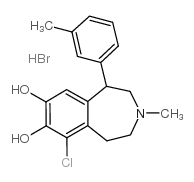Phenotype of spontaneous orofacial dyskinesia in neuregulin-1 'knockout' mice.
Katsunori Tomiyama, Colm M O'Tuathaigh, Gerard J O'Sullivan, Anthony Kinsella, Donna Lai, Richard P Harvey, Orna Tighe, David T Croke, Noriaki Koshikawa, John L Waddington
文献索引:Prog. Neuropsychopharmacol. Biol. Psychiatry 33(2) , 330-3, (2009)
全文:HTML全文
摘要
Studies in antipsychotic-naïve patients with schizophrenia indicate a baseline level of spontaneous involuntary movements, particularly orofacial dyskinesia. Neuregulin-1 is associated with risk for schizophrenia and its functional role can be studied in 'knockout' mice. We have shown previously that neuregulin-1 'knockouts' evidence disruption in social behaviour. Neuregulin-1 'knockouts' were assessed for four topographies of orofacial movement, both spontaneously and under challenge with the D(1)-like dopamine receptor agonist SKF 83959. Neuregulin-1 'knockouts' evidenced an increase in spontaneous incisor chattering, particularly among males. SKF 83959 induced incisor chattering, vertical jaw movements and tongue protrusions; the level of horizontal jaw movements was increased and that of tongue protrusions decreased in neuregulin-1 'knockouts'. These findings indicate that the schizophrenia risk gene neuregulin-1 is involved in the regulation of not only social behaviour but also orofacial dyskinesia. Orofacial dyskinesia in neuregulin-1 mutants may indicate some modest genetic relationship between risk for schizophrenia and vulnerability to spontaneous movement disorder.
相关化合物
| 结构式 | 名称/CAS号 | 分子式 | 全部文献 |
|---|---|---|---|
 |
SKF83959
CAS:80751-85-5 |
C18H21BrClNO2 |
|
SKF83959 is a potent allosteric modulator of sigma-1 recepto...
2013-03-01 [Mol. Pharmacol. 83(3) , 577-86, (2013)] |
|
The D₁ dopamine receptor agonist, SKF83959, attenuates hydro...
2012-01-01 [Mol. Vis. 18 , 2882-95, (2012)] |
|
Phosphatidylinositol-linked novel D(1) dopamine receptor fac...
2009-08-01 [Neuropharmacology 57(2) , 164-71, (2009)] |
|
Assessment of jaw movements by magnetic sensor in relation t...
2010-04-25 [Eur. J. Pharmacol. 632(1-3) , 39-44, (2010)] |
|
Regulation of DARPP-32 phosphorylation by three distinct dop...
2008-11-01 [J. Neurochem. 107(4) , 1014-26, (2008)] |